by Matthew Orwat | Jan 7, 2014
On the night of January 6-7th 2014 Northwest Florida was hit with a major freeze event. While many areas reached 18 º F, the West Florida Research & Education Center near Jay reached 14 º F. Similar freezing temperatures are predicted for the night of January 7-8.
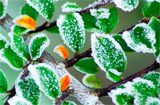
Frosted plant. Image Credit UF IFAS Extension
Strategies for ornamental plant protection before, during, and after freeze events:
- Water: Your best friend is water because well watered soil retains more heat, and a well watered plant has less chance of drying out during an advective freeze (freeze caused by cold air mass, with wind).
- Move containerized plants indoors, especially tropical or subtropical plants, annuals or herbs. Containerized woody ornamental shrubs can be left outside, but place them in a sheltered area or south-facing side of a structure.
- When covering sensitive plants, including row covers for vegetable gardens, the covers should extend to the ground. This allows the heat from the soil to radiate within the covered area. Light bulbs or strings of lights help extend the protection covered plants. Be sure to remove covers when temperatures warm, since covers will trap excessive heat during warm periods.
- After the freeze event, water the plant well. Plants lose water through transpiration after freeze events and may not be able to take up water as readily if root damage occurred. This will also help thaw the soil of exposed containerized plants.
For additional information, check out this UF IFAS page on Freeze Protection of Ornamental Plants
Here are some protection tips specific to the home citrus garden:
- Generally, satsuma are cold tolerant down to 15° F, but young trees or trees yet to achieve dormancy are usually only tolerant to 26°F. Fruit should not sustain damage from freezing temperatures above 25°F. In fact, temperatures between 25°F and 35°F enhance the sweetness of the fruit.
- Extreme winds sometimes make the effects of freeze events worse if the trees are not well watered. A well hydrated tree is a well protected tree. On the whole, still nights make for worse freeze events since cold air will “settle” into low areas.
- Wrap the trunk with commercial tree wrap or mound soil around the base of the tree up to 2 feet. This will protect the graft of the young tree. Thus, if the branches freeze the graft union will be protected.
- For established citrus trees, mound soil around the tree in a cone formation. Do not mulch the trees over the winter since heat that radiates up from the soil will be blocked somewhat by mulch.
- Young trees (those under 6 feet tall) can be covered the tree with a cloth sheet or blanket. For additional protection, large bulb Christmas lights can be placed around the branches of the tree. This will increase the temperature under the cover by several degrees. Be sure to use outdoor lights and outdoor extension cords to avoid the potential of fire.
- Always remember to remove cold protection once the temperature rises so that the trees do not overheat.
- Do not cover trees with plastic tarp, these will not protect the tree and can “cook” the tree once the sun comes out.
- Water citrus trees. Well watered trees have increased cold hardiness. Do not over-water. If the ground is moist, it is not necessary to water.
- Frames may be installed around young trees to hold the cover. This option keeps the blanket or sheet from weighing down the branches.
- Micro-irrigation is an option. This practice will protect citrus trees up to 5 feet, but must be running throughout the entire freeze event. It needs to be turned on at 36ºF and left on until the temperature reached 42 ºF. If the tree is too large for complete coverage, the emitter should be located on the windy side of the tree. Be sure that the water covers the graft union, since most trees will recover from any freeze if the union is not damaged. For additional information read this publication on micro-sprinkler irrigation.
- Kumquats are the most cold tolerant citrus type grown in Northwest Florida, so protection of fruit is not required unless freeze events reach 20°F. Established tree can withstand colder temperatures without protection.
For additional information, contact your local extension office.
by Gary Knox | Jan 7, 2014
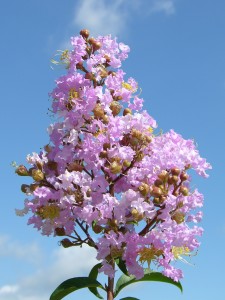
‘Apalachee’ has light lavender flowers. Photo by Gary Knox
‘Apalachee’ crapemyrtle is a statuesque small deciduous tree with lavender flowers, dark green leaves and cinnamon-orange bark. Lagerstroemia indica x fauriei ‘Apalachee’ is one of the hybrids released in 1987 from the breeding program of the U.S. National Arboretum. It grows as an upright to vase-shaped, multi-stemmed tree in USDA Cold Hardiness Zones 7a-9b.
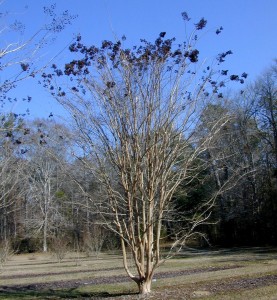
Seed capsules of ‘Apalachee’ add winter interest. Photo by Gary Gnox
Seed capsules add unexpected winter ornament to the leafless branches of the deciduous tree. Because individual flowers are packed tightly in the flower panicle, the seed capsules are correspondingly closely spaced. Persisting seed capsules add interest to the tree’s profile similar to the way dried flowers of oakleaf hydrangea continue to add interest long after the flowers have faded.
Crapemyrtle grows and flowers best in full sun with rich, moist soil but is tolerant of drought and all but wet soils. ‘Apalachee’ has good resistance to powdery mildew, very good resistance to cercospora leaf spot and moderate resistance to flea beetle (Altica sp.). This hybrid is susceptible to crapemyrtle aphid. ‘Apalachee’ performs best with minimal pruning. Crapemyrtle is best located away from pavement and structures that may be stained by fallen flowers.
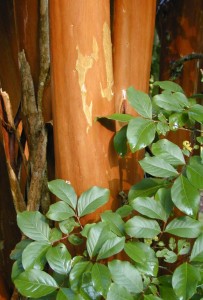
Cinnamon-orange bark of ‘Apalachee’. Photo by Gary Knox
‘Apalachee’ grew to a height of 26 feet and a width of 21 feet in 15 years at former University of Florida facilities in Monticello, Florida. It was one of the most outstanding crapemyrtles in that evaluation planting. This crapemyrtles’ form, vigorous growth, dark green leaves, lavender flowers, cinnamon-orange bark, and persistent seed capsules give it year-round appeal and allow it to stand out among crapemyrtle cultivars.
Lagerstroemia indica x fauriei ‘Apalachee’ has not yet been evaluated using the IFAS Assessment of Non-Native Plants in Florida’s Natural Areas. Without this assessment, the temporary conclusion is that Lagerstroemia indica x fauriei ‘Apalachee’ is not a problem species at this time and may be recommended.
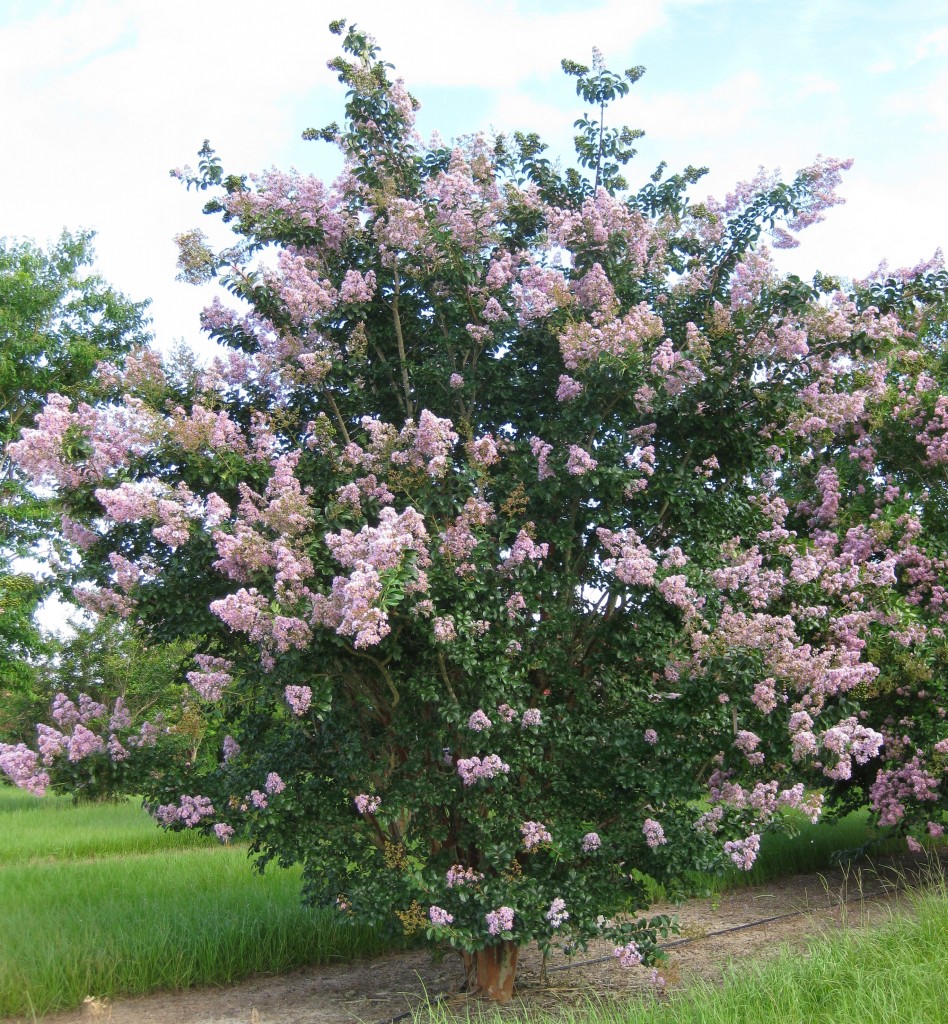
‘Apalachee’ crapemyrtle in full bloom. Photo by Gary Knox
by Mary Salinas | Jan 7, 2014
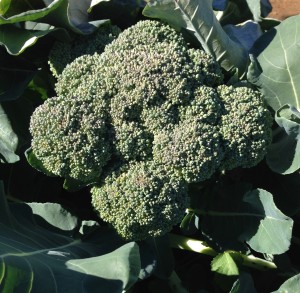
Broccoli, a popular winter vegetable. Photo by Mary Derrick, UF IFAS
In the Florida panhandle, we are fortunate to be able to grow crops throughout the year. The key is to know what to plant at the various times of the year.
Vegetables that can be planted now include beets, broccoli, cabbage, carrots, cauliflower, Chinese cabbage, collards, kale, kohlrabi, lettuce, green onions, English peas, radish and turnips. For those that are started from seed, especially carrots and radish, sow seed every 2 to 3 weeks to stagger the harvest.
During this cool time of the year, take stock of the vegetable garden area and decide if changes need to be made, such as moving or adding on to it. This is a good time of year to do the heavy labor before the warm, sweaty weather sets in. A popular choice is to add raised beds for growing herbs and vegetables. An advantage of a raised bed is that the garden starts with clean, rich soil that is weed and pest free. Grass and weeds do not have to be dug out for the garden; they can simply be covered by heavy groundcloth, newspaper or cardboard and the raised bed is placed on top.
[important]Consider getting a soil test if one has not been done within the past few years. Always get a soil test before adding lime – it will indicate if lime is needed and exactly how much to apply for best results. The cost is only $7 through the University of Florida. Contact the local Extension office for a soil test kit.[/important]
Stepping outside of the vegetable garden for a moment, for those interested in deciduous fruit such as peaches, pears and apples this is a great time to plant trees to give their roots time to develop before the warm, dry spring months. Be sure to select varieties that are proven performers for North Florida.
For further information please see:
Florida Vegetable Gardening Guide
Gardening in Raised Beds
Soil Sampling and Testing for the Home Landscape or Vegetable Garden
Deciduous Fruits for the Home Gardener in North Florida and North Central Florida






